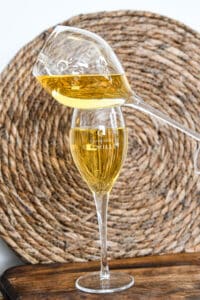
COMPOSITION OF CHAMPAGNE – OENOLOGICAL PARTICULARITIES
When discussing the composition of Champagne, one inevitably thinks of the three grape varieties that account for 99% of production: Pinot Noir, Meunier, and Chardonnay.
Summary
The world of Champagne is vast and varied, offering a multitude of choices for wine enthusiasts. Among these options, two categories stand out: Non-Vintage Brut Champagne (often abbreviated as BSA) and Vintage Champagne. While these two types of Champagne are often confused, they have distinct characteristics that are worth exploring. In this article, we will detail the differences between a Non-Vintage Brut Champagne and a Vintage Champagne, helping you make the best choice for your tastings.
What is a Non-Vintage Brut Champagne?
Non-Vintage Brut Champagne, commonly abbreviated as BSA, is the most widely available type of Champagne on the market. But what makes it unique?
What is a Vintage Champagne?
Vintage Champagne, on the other hand, is produced only in years deemed exceptional by the Champagne houses. Here’s what sets it apart:
How to choose between a Non-Vintage Brut and a Vintage Champagne?
The choice between a Non-Vintage Brut and a Vintage Champagne primarily depends on your personal preferences and the occasion.
Conclusion
In summary, Non-Vintage Brut Champagne is a consistent expression of a Champagne house’s craftsmanship, offering freshness and versatility that suits many situations. Vintage Champagne, on the other hand, is a unique expression of a particular year, offering complexity and depth that make it perfect for special occasions.
Whether you choose a Non-Vintage Brut or a Vintage Champagne, each type offers its own tasting experience, enriching your knowledge and appreciation of this iconic sparkling wine.

When discussing the composition of Champagne, one inevitably thinks of the three grape varieties that account for 99% of production: Pinot Noir, Meunier, and Chardonnay.

For many decades, the production of Champagne has followed a precise and well-established process. The making of Champagne respects traditions and practices, which Maison Gremillet

Understanding the Difference Between Non-Vintage Brut Champagne and Vintage Champagne. The world of Champagne is vast and varied, offering a multitude of choices for wine